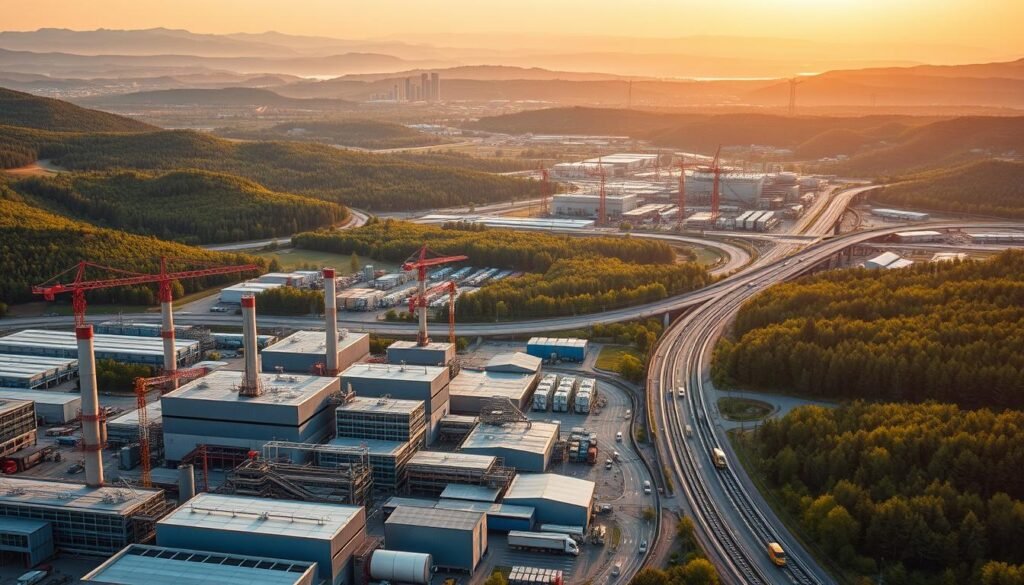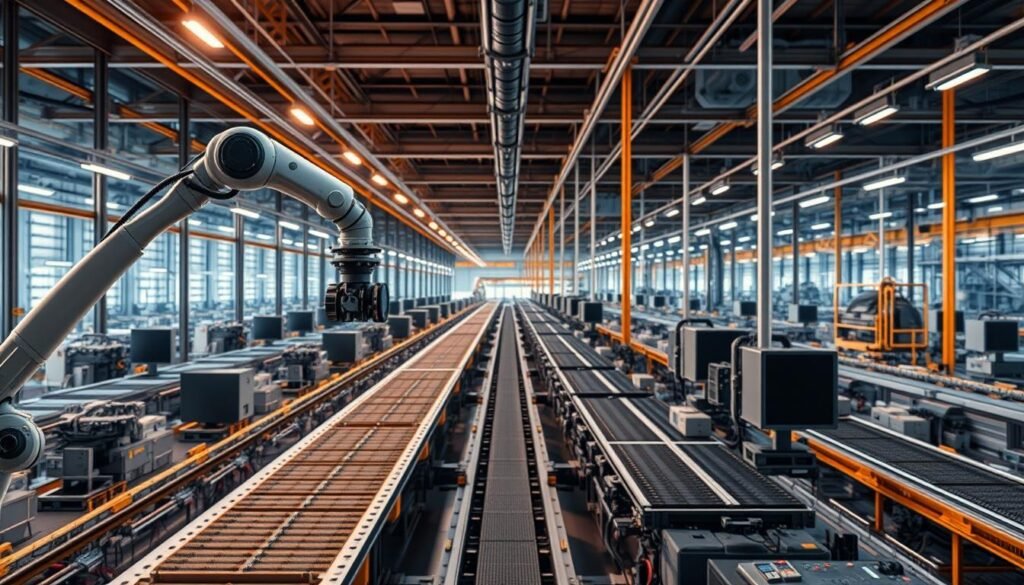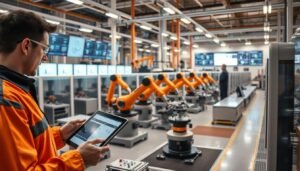The manufacturing industry has come a long way since its early days. From artisanal craftsmanship to the assembly lines pioneered by Ford, the sector has always embraced innovation. Today, data science is driving a new era of transformation, reshaping how goods are produced and optimized.
In the U.S., manufacturers are leveraging predictive analytics and big data to enhance operational efficiency. These technologies help identify patterns, reduce waste, and improve decision-making. The integration of data science is not just a trend; it’s a necessity for staying competitive in a rapidly evolving market.
From historical milestones to modern advancements, the industry continues to evolve. By embracing technology, manufacturers are paving the way for smarter, more sustainable production methods. The future of manufacturing is here, and it’s powered by data.
Key Takeaways
- Data science is transforming the manufacturing industry.
- Ford’s assembly line marked a significant historical shift.
- Predictive analytics improves operational efficiency.
- Big data helps reduce waste and optimize processes.
- U.S.-based manufacturers are leading in technological integration.
- Technology is essential for staying competitive in modern manufacturing.
Understanding the Modern Manufacturing Landscape
The journey of production methods has seen dramatic shifts over centuries. From handmade goods crafted by artisans to the rise of large-scale factories, the way we produce has transformed significantly. This evolution has shaped economies and industries worldwide.
Historical Evolution from Artisan to Factory System
Before the Industrial Revolution, goods were made by skilled artisans. Each item was unique, crafted with care and precision. However, this method was time-consuming and limited in scale. The introduction of steam power in the 18th century changed everything. Factories emerged, enabling mass production and efficiency.
In the U.S., this shift played a crucial role in economic growth. The ability to produce goods faster and cheaper helped the nation become an industrial powerhouse. Electrical power later replaced steam, further advancing production capabilities.

Contemporary Industrial Practices and Technologies
Today, industrial practices are driven by innovation. Techniques like batch production, flow production, and just-in-time methods have revolutionized how goods are made. These methods reduce waste and improve efficiency, ensuring products meet market demands swiftly.
Modern systems integrate digital technologies, creating smarter production processes. The U.S. continues to lead in adopting these advancements, maintaining its competitive edge. From historical roots to cutting-edge practices, the evolution of production methods reflects humanity’s drive for progress.
Data Science Innovations in Industrial Manufacturing
In today’s industrial landscape, data science is reshaping how production processes operate. By leveraging advanced analytics, manufacturers are achieving higher efficiency, better quality control, and optimized workflows. These innovations are not just enhancing operations but also creating a more skilled workforce.

Predictive Maintenance and Process Optimization
One of the most impactful applications of data science is predictive maintenance. By analyzing equipment data, manufacturers can predict failures before they occur. This prevents costly downtime and extends the lifespan of machinery.
Process optimization is another key area. Real-time monitoring and big data analytics help identify inefficiencies. This allows for immediate adjustments, ensuring smoother operations and reduced waste.
Integrating Big Data with Traditional Techniques
Traditional methods are being enhanced with modern data-driven insights. For example, U.S.-based manufacturers are combining legacy practices with new digital tools. This balance ensures continuity while embracing innovation.
Big data also plays a crucial role in supply chain management. By analyzing vast datasets, companies can make informed decisions, improving both speed and accuracy.
Advancements in Quality Control and Efficiency
Data science is revolutionizing quality control. Advanced algorithms detect defects early, reducing errors and costs. This ensures that products meet high standards consistently.
Efficiency gains are also significant. Automated systems powered by data analytics streamline workflows. This not only boosts productivity but also supports a more skilled workforce.
As the industrial sector evolves, data science remains at the forefront. It’s driving a new era of innovation, making production smarter and more sustainable.
Leveraging Data for Operational Efficiency
Modern manufacturers are turning to data to streamline their operations and reduce costs. By integrating advanced analytics, they are achieving significant improvements in supply chain management and inventory control. This shift is not just about technology; it’s about making smarter decisions that drive efficiency and sustainability.
Streamlining Supply Chain and Inventory Management
Data science is transforming how supply chains operate. Real-time data analysis helps manufacturers track inventory levels, predict demand, and optimize logistics. This reduces waste and ensures that products are delivered on time.
For example, U.S.-based companies are using ERP systems to integrate data across departments. This provides a holistic view of operations, enabling better decision-making. IoT sensors also play a crucial role, offering real-time insights into equipment performance and inventory status.
Cost Reduction through Data-Driven Insights
One of the most significant benefits of data science is cost reduction. By analyzing production data, manufacturers can identify inefficiencies and implement targeted improvements. This leads to lower operational costs and higher profitability.
Case studies show that companies leveraging data insights have reduced waste by up to 20%. Technologies like machine learning models are helping manufacturers optimize the make process, ensuring resources are used effectively.
These advancements are driving an industrial transformation, where data-driven decision-making is becoming the norm. By embracing these tools, manufacturers are not only improving their bottom line but also contributing to a more sustainable future.
Manufacturing’s Role in Economic Growth and Workforce Development
The U.S. industrial sector continues to be a cornerstone of economic growth. It contributes significantly to the nation’s GDP and drives job creation across various regions. By integrating advanced technologies, this sector is not only boosting output but also shaping a modern workforce.
Impact on U.S. Industrial Output and Employment
Manufacturing plays a vital role in the U.S. economy, accounting for a notable percentage of GDP. It supports millions of jobs, from production lines to engineering roles. The sector’s ability to adapt to new technologies ensures its continued relevance in a competitive global market.
For example, the adoption of automation and data analytics has streamlined operations. This has led to increased productivity and reduced costs. These advancements are creating opportunities for skilled workers, fostering a more dynamic labor market.
Innovations Driving the Modern Workforce
Innovative practices are transforming how the workforce operates. Technologies like AI and IoT are enabling workers to focus on higher-value tasks. This shift is creating demand for high-skilled jobs in areas such as robotics, data analysis, and systems engineering.
Training programs and partnerships with educational institutions are helping bridge the skills gap. These initiatives ensure that the workforce is equipped to handle the demands of a digital-first industrial environment.
Challenges remain, such as ensuring equitable access to training and addressing job displacement. However, the opportunities for economic and workforce development are immense. By embracing innovation, the U.S. industrial sector is paving the way for a prosperous future.
Conclusion
From handcrafted goods to data-driven systems, the evolution of production has been remarkable. Data science has revolutionized the industrial sector, enhancing efficiency, quality control, and predictive maintenance. These advancements are transforming the U.S. state of manufacturing, driving economic growth and creating opportunities for a skilled workforce.
The integration of technologies like AI and IoT ensures that the industrial sector remains competitive. A skilled workforce is essential to adopt and adapt to these innovations, paving the way for a sustainable future.
As the landscape evolves, ongoing innovation will be crucial. Data science will continue to shape the industrial environment, ensuring that production methods meet future demands in an increasingly competitive market.






















8 thoughts on “Data Science in Manufacturing: Case Studies & Practical Applications”
Після всього, що я почув про PhiWave Festival, я вже не можу дочекатися, щоб побувати там наступного разу. Мої друзі розповідали про виступи Amelie Lens і Stephan Bodzin, які стали справжнім відкриттям. Танцпол із хвилястими інсталяціями і лазерними шоу був схожий на витвір мистецтва. Це подія, яка залишила у моїх друзів лише найкращі враження.
Write more, thats all I have to say. Literally, it seems as though you relied on the video to make your point. You definitely know what youre talking about, why waste your intelligence on just posting videos to your site when you could be giving us something enlightening to read?
you’re really a good webmaster. The website loading pace is incredible. It seems that you’re doing any distinctive trick. In addition, The contents are masterwork. you’ve performed a great activity in this matter!
Fantastic goods from you, man. I’ve have in mind your stuff previous to and you’re just too fantastic. I actually like what you have got right here, really like what you’re saying and the way in which by which you are saying it. You’re making it entertaining and you continue to take care of to stay it smart. I can’t wait to read much more from you. This is really a wonderful site.
**mindvault**
mindvault is a premium cognitive support formula created for adults 45+. It’s thoughtfully designed to help maintain clear thinking
It’s really a nice and useful piece of info. I’m glad that you shared this helpful information with us. Please keep us informed like this. Thanks for sharing.
It’s the best time to make some plans for the long run and it’s time to be happy. I’ve read this put up and if I may I want to counsel you some fascinating issues or tips. Maybe you can write next articles regarding this article. I desire to read even more issues approximately it!
**breathe**
breathe is a plant-powered tincture crafted to promote lung performance and enhance your breathing quality.